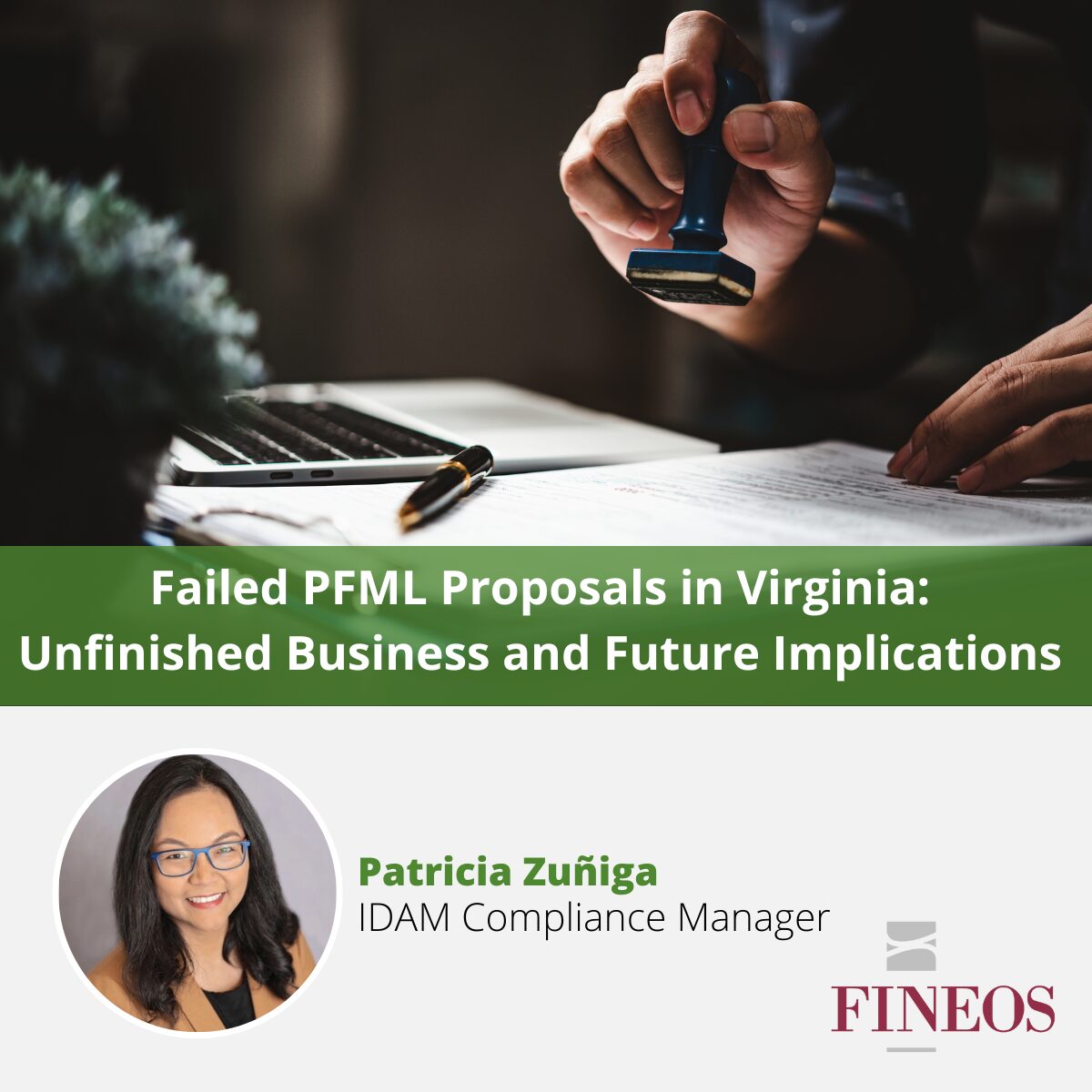On April 9, Maryland lawmakers passed the nation’s next paid family and medical leave program by overriding Gov. Larry Hogan’s veto of Maryland Senate Bill 275, the Time to Care Act of 2022, Maryland Family and Medical Leave Insurance Program (MD PFML). Contributions to the program must begin by October 1, 2023, and employees may begin receiving benefits on January 1, 2025. Private plans are allowed under this new law, as further described below.
The MD PFML law directs the Secretary of Labor to adopt regulations necessary to carry out the new law. The timing of such regulations is uncertain. The law requires that the regulations be consistent with the federal FMLA regulations and relevant state law, unless they conflict with the MD PFML. No doubt there will be much more about the implementation of this law through Maryland’s regulatory process, and FINEOS will stay engaged throughout. We look forward to updating this blog as new information is available. Read on for more details on this new statutory PFML program.
Benefits
Minimum & Maximum: The minimum benefit amount is $50, and the maximum is $1,000 beginning January 1, 2025. For the 12-month period beginning January 1, 2026, and each subsequent 12-month period, the maximum amount will be determined and announced by the Secretary of Labor, based on the annual percentage growth in the consumer price index for the immediately preceding 12-month period.
Calculation: An employee’s average weekly wage is calculated as the total wages received in the prior 680 hours that the employee was paid divided by the number of weeks worked. The weekly benefit amount is calculated as:
- 90% of the employee’s AWW, up to 65% or less of the state average weekly wage
- 50% of the employee’s AWW, for any part that is greater than 65% of the state average weekly wage
For partially paid leave, the employee receives the lesser of:
- The amount required to make up the difference between the wages paid to the employee while the employee is taking partially paid leave and the full wages normally paid to the employee; and
- If the employee’s average weekly wage is greater than 65% of the state average weekly wage, the sum of:
- 90% of the employee’s average weekly wage up to 65% of the state average weekly wage; and
- 50% of the employee’s average weekly wage that is greater than 65% of the state average weekly wage.
Note: For employees taking partially paid leave, the weekly benefit maximum is the same as for an employee taking a full week of leave (see below). For partially paid leave, this benefit maximum does not appear to be offset by the wages the employee is already receiving. Therefore, it appears possible that an employee could receive up to $1000 in benefits per week for a partial week of leave, as long as that amount plus the amount they are being paid by their employer does not exceed their full wages normally paid.
Amount of Leave: An employee can take 12 weeks of paid leave in an Application Year (defined below). An employee can receive an additional 12 weeks of paid leave if the employee (during the same Application Year) receives benefits for bonding leave and becomes eligible for leave for the employee’s own serious health condition, or vice versa. The law is not clear whether the additional 12 weeks of leave must be used for the second leave reason, or whether it is available for any of the permissible leave reasons. FINEOS will seek clarification through the lawmakers and regulatory process.
Private Plans: An employer can satisfy the requirements of the MD PFML law through a private employer plan consisting of employer-provided benefits, insurance, or a combination of both if the private employer plan is offered to all of the employer’ s eligible employees and meets or exceeds the rights, protections, and benefits under the state’s program.
Eligible Employee: Employees who work at least 680 hours over the 12-month period preceding leave are eligible for MD PFML.
Covered Employers: All employers that employ at least one employee in Maryland are covered.
Covered Leave Reasons: MD PFML allows employees to take leave for:
- Bonding with a child during the first year after the child’s birth or after the placement through foster care, kinship care, or adoption;
- Caring for a family member with a serious health condition;
- An employee’s serious health condition;
- Caring for a service member who is the employee’s next of kin; or
- A qualifying exigency arising out of the deployment of a service member who is a family member of the employee.
Covered Family Members: MD PFML defines a covered family member as the employee’s:
- Child (biological, adopted, foster, step, legal or physical ward, in loco parentis)
- Parent (biological, adopted, foster, step, in-law, guardian, in loco parentis)
- Spouse
- Grandparent (biological, adopted, foster, step)
- Grandchild (biological, adopted, foster, step)
- Sibling (Grandparent (biological, adopted, foster, step)
Contributions: Beginning October 1, 2023, an employee, an employer with 15 or more employees, and a self-employed individual participating in the program must contribute to the Family and Medical Leave Insurance Fund. On or before December 1 every 2 years, beginning in 2025, the Secretary of Labor, with state agencies and relevant stakeholders, will conduct a cost analysis of the program that is focused on the cost of maintaining solvency and paying benefits to employees. The Secretary of Labor will make recommendations regarding the proportion of rate contributions between employers and employees.
Calendar Method: MD PFML uses a rolling forward 12-month period, beginning on the 1st day of the calendar week that the employee files an application of benefits. Note that 1) the law does not define calendar week (i.e., does that begin on Sunday, Monday, or another day?) and 2) the period kicks off from the date of filing the application, not the first day of leave. “Filing of the application” is not a defined term.
Type of Leave: Employees may take leave on an intermittent leave schedule. If leave is taken on an intermittent leave schedule, employee must make a reasonable effort to schedule the intermittent leave in a manner that does not unduly disrupt the operations of the employer and provide the employer with reasonable and practicable prior notice of the reason for which the intermittent leave is necessary. Employees may not take intermittent leave in an increment of less than 4 hours.
Concurrency: Leave under MD PFML runs concurrently with leave under the federal FMLA. An employee must exhaust all employer-provided leave that is not required to be provided under law before receiving benefits under MD PFML. While the employee is using that employer-provided leave, that leave is subject to the job protection provided under MD PFML. The law does not specify whether this employer-provided leave must be paid, or how an employer’s unlimited PTO policy would interact with this provision. Employees are not eligible for MD PFML benefits if they are receiving workers’ compensation benefits but may be eligible if they are receiving compensation for a permanent partial disability under the workers’ compensation program.
Employee Notice: If the employee’s need for leave is foreseeable, an employer may require an employee to provide the employer with written notice of the employee’s intention to take leave at least 30 days before commencing the leave. If the need to use leave is not foreseeable, the employee must provide notice to the employer as soon as practicable; and comply with the employer’s notice or procedural requirements for requesting or reporting other leave, if those requirements do not interfere with the employee’s ability to use leave for which benefits are payable.
Employer Notice: Employers must provide written notice to each employee of the rights and duties of an employee under MD PFML at the time of hire and annually thereafter. When an employee requests leave under MD PFML, or when an employer knows that an employee’s leave may be for a reason under MD PFML, the employer must notify the employee within 5 business days of the employee’s eligibility to take leave for which benefits may be paid under this title . The notice must include:
- the right of an eligible employee to receive program benefits;
- the procedure for filing a claim for benefits;
- an eligible employee’s responsibilities with respect to providing notification prior to the commencement of leave and any penalties for failing to do so;
- the right of an employee to file a complaint for alleged violations of the MD PFML;
- the right of an eligible employee to job protection; and
- a description of the prohibited acts, penalties, and complaint procedures under MD PFML.
Job Protection: During a period in which an employee is taking MD PFML, an employer can only terminate an employee for cause. An employer must restore an employee’s employment unless:
- the employer can show that denial of job restoration is necessary to prevent substantial and grievous economic injury to the operations of the employer;
- the employer notifies the employee of the intent of the employer to deny restoration at the time the employer determines the economic injury would occur; and
- the leave has already begun, and the employee elects not to return to employment after receiving notice of the employer’s intention to deny restoration of employment.
Maintenance of Health Insurance Benefits: Employers must continue any employment health benefits for the time that the employee is absent from work or receiving benefits under MD PFML.
How is FINEOS helping carriers and employers prepare for paid leave programs?
FINEOS will be ready to administer this new leave law, especially for carriers seeking private plans to comply with MD PFML. Using modern insurance technology solutions like the FINEOS Platform can help insurance carriers remain agile and competitive when leave legislation is passed. Learn more about how a modern, integrated disability and absence management (IDAM) solution can help your organization adapt to sudden changes and remain in compliance here.


